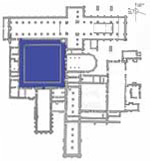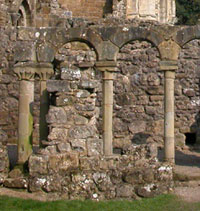 |
 |
 |
 |
 |
 |
 |
|
The cloister
Paradise is among us here in spiritual exercise, simple prayer and holy meditation.(1) The cloister stood at the centre of the precinct, where it was sheltered from noise and disruption. The cloister at Rievaulx was c. 42sq. m (140 ft) and dates from William’s abbacy (1132-1145). It was made up of a large central area surrounded by an open arcade; five of the original twelfth-century cloister arcades survive and have been re-erected in the NW corner of the cloister. Aelred’s treatise on friendship, c. 1160, suggests that this central area was not originally grassed, for he mentions that at this time there were flowers and fruit trees: The day before yesterday, as I was walking the round of the cloister of the monastery, the brethren were sitting around forming, as it were, a most loving crown. In the midst, as it were, of the delights of paradise with the leaves, flowers and fruits of each single tree I marvelled.(2)
Access to the cloister was restricted and the monks observed silence here, which meant that this was well suited to meditation and prayer. The south, east and west cloister walkways essentially functioned as passageways, while the north alley was used extensively by the monks who sat here on stone benches to read, meditate and perhaps also to copy manuscripts. In the later Middle Ages there were carrels or desks here for the monks.(3) The novice-master might instruct novices here and the whole community gathered in the north cloister walk for the daily Collation reading.(4) The cloister would have been warm and bright in the summer, but the monks would have found it rather bleak during the chilly winter months. When it was extremely cold they were permitted to read in the chapter-house, instead. |
 (1/2)
(1/2)